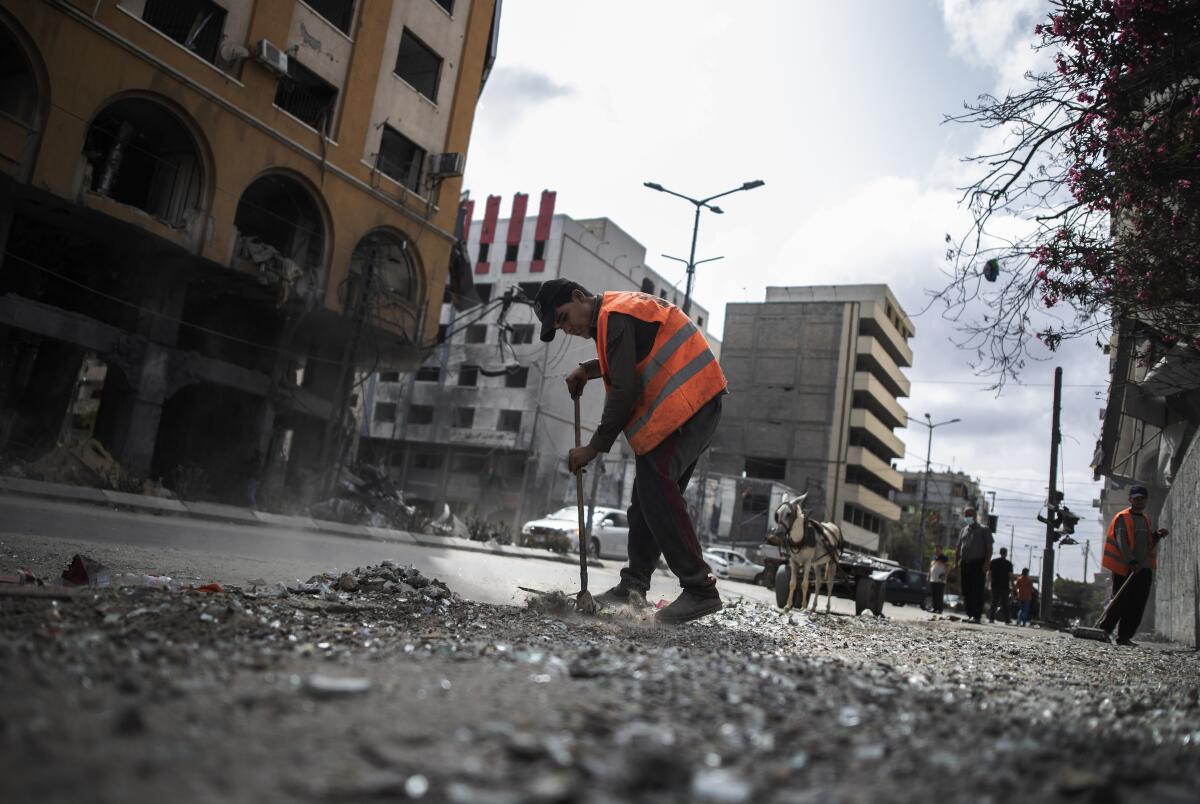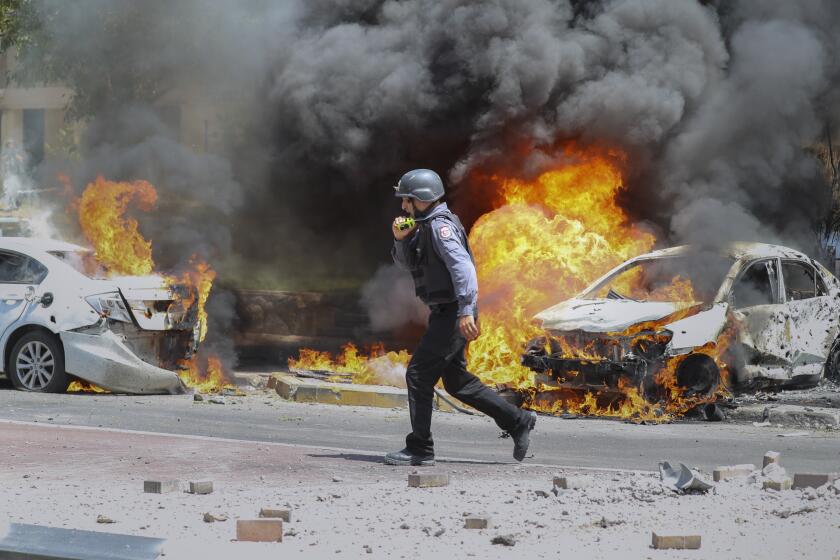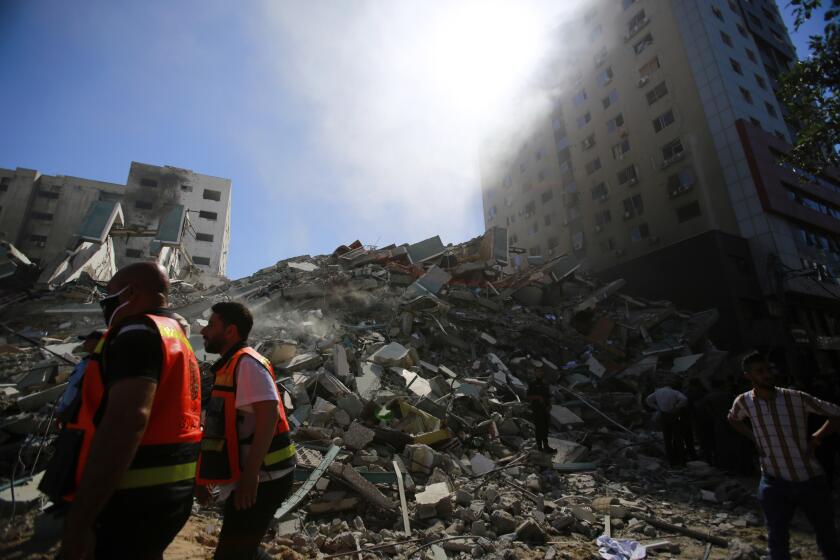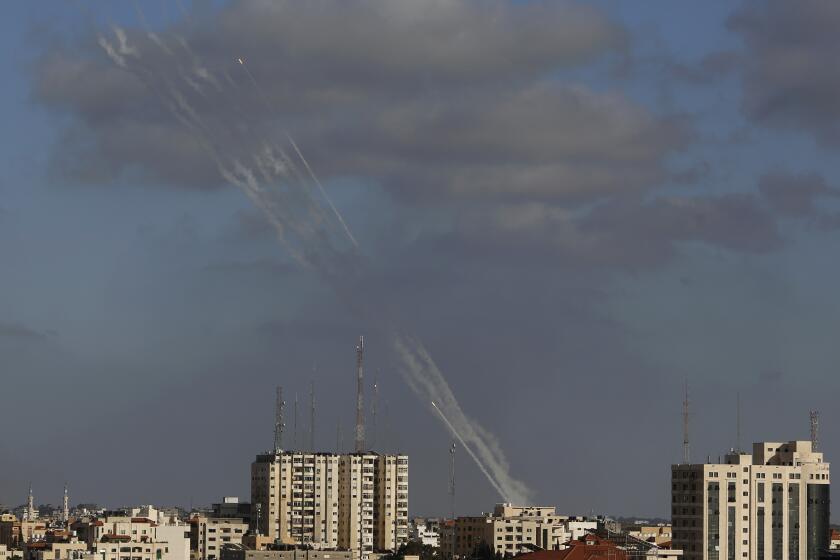Cease-fire holds during first day as Palestinians, Israelis take stock

- Share via
GAZA CITY — In Gaza and across the south of Israel on Friday, the soundtrack of war — the whoosh of Israeli F-16s, the roar of concrete collapsing into rubble, the shriek of a rocket fired into Israel — gave way to the quotidian sounds of traffic, murmured prayers and sporadic celebration.
Hours into a cease-fire between Israel and Hamas, people emerged from their bunkers and battered homes into a morning of relative peace. Calm had come after 11 days of bloodletting that left hundreds — the vast majority Palestinians — dead or wounded and upended the lives of tens of thousands of others.
The moment the cease-fire began early Friday, Gazans poured into the streets to celebrate. Many fired machine guns into the air as muezzins broadcast “God is great” from the loudspeakers of mosques. They lit fires and danced in the ruins. The dead were still being counted, the damage assessed. But the skies were quiet and the earth had stopped shaking.
“Eid al-Fitr came to us when the battle was happening, so we didn’t feel it until the truce,” said farmer Akram Abu Khoussa, 46, referring to the celebration that marks the end of Ramadan, which had coincided with the outbreak in armed hostilities.
Across the Gazan border and farther up the coast, people in one part of Tel Aviv were out getting their hair cut in barbershops and salons. Parents pushed baby strollers, kids whizzed around on scooters.
“I feel a lot better. Not totally relaxed, but what’s most important is that there’s no fighting right now, no one is being killed or injured,” Dganit Eyal, a 59-year-old occupational therapist, said after shopping at a health-food store and walking her dog.
The cease-fire, brokered by Egypt with pressure from the United States and other international brokers, held through Friday and halted the worst bout of violence between Israelis and Palestinians since 2014. Both Israel and Hamas militants in Gaza claimed victory.
But in a sign that the grievances at the heart of the conflict have not been resolved, violent faceoffs were reported at Al Aqsa Mosque in Jerusalem, where Israeli police fired rubber-covered steel bullets and sound grenades at thousands of Palestinian worshipers gathered for Friday prayers. The Palestinian Red Crescent reported that 20 people were injured.
It was unclear how the confrontation began, but it followed Palestinians cheering and raising flags in celebration in Al Aqsa’s courtyards. Israeli police described the unrest as a “riot.” Although it quickly simmered down, the incident was similar to the confrontations that sparked the war’s start May 10, underscoring the fragility of the cease-fire now in place.
Later, a number of Palestinians demonstrated in the Sheik Jarrah neighborhood in East Jerusalem, where some Palestinian families face eviction by Jewish settlers.
During the armed conflict, fierce Israeli airstrikes and artillery bombardment killed more than 243 Palestinians in Gaza, including 66 children, according to the health ministry. The barrage reduced parts of the impoverished, densely populated enclave — including residential towers, commercial centers, schools, roads and other infrastructure — to rubble.
In Israel, 12 people, including two children, were killed as a result of more than 4,000 rockets fired out of Gaza and into Israel.
For thousands of Israelis and Palestinians alike, Friday marked a delicate day of picking up the pieces.
In their latest war with Israel, Hamas militants have lobbed more than 4,000 projectiles, reaching deeper into Israeli territory than ever before.
In Gaza, Mohammad Naseer said the pounding by Israeli warplanes and tanks had wrecked both his home and his economic prospects.
“We haven’t gone back to the house — it was destroyed on the sixth day of the conflict when a shell hit it,” said Naseer, 37, who along with his wife, seven daughters and two sons was still at his sister’s place.
An Israeli airstrike destroyed a building in Gaza City that housed offices of the Associated Press and other media outlets.
The battles — in which Israel had overwhelming military superiority — meant that Naseer, who doesn’t have steady employment, was unable to go out and find construction work. “I can’t stay at my sister’s, but I can’t afford to pay rent anywhere. I don’t know what to do,” he said.
With Eid al-Fitr approaching, Khaled Walid had invested all the money he owned in merchandise for his store in the upscale Gaza City neighborhood of Al Rimaal. But a missile smacked into a building nearby, destroying his place in the fallout.
“This is the second time it happened to me, and I can tell you this time it’s worse. I lost some $50,000 in this,” he said. He now faced the prospect of selling his car or getting a loan from his brothers in a bid to stay afloat.
“I’m going to try all I can. At least we came out safe from this war,” he said.
Breaking News
Get breaking news, investigations, analysis and more signature journalism from the Los Angeles Times in your inbox.
You may occasionally receive promotional content from the Los Angeles Times.
What Roni Keidar feels most is exhaustion. The 77-year-old spent the last 11 days in the safe room of her house in a farming village on the Israeli side of the Gaza border.
Her neighbors in Netiv Ha’asara have begun venturing out, although they have been instructed not to go too far from their homes when in the village, so they can get to shelter quickly if needed.
“We can go out of the village now and people can come in, but only through the back way, because the main road is very exposed,” she said, adding that authorities feared a stray militant attack or an incoming mortar shell.
Before fighting broke out, her house was being repainted and undergoing some renovations. Now “everything is in upheaval” she said, but after the weekend, she hopes the workers will be able to come finish the job.
Keidar, a longtime peace activist, said she had kept in touch with fellow activists in Gaza during the fighting.
“Where are we going now? Where will we go tomorrow?” she said of the conflict.
“It’s not my land and not their land. It’s land meant for both of us, and we need to realize that and find a way and live in dignity and respect for one another.”
Hamas officials said Friday that the cease-fire was proof the group had been able to strike a “painful blow” against its Israeli adversary.
“I congratulate you for this great victory recorded by the defiant resistance,” said Hamas political chief Ismail Haniyeh in a speech broadcast from Qatar, adding that he considered the fight “a quantum leap in the history of the struggle with the enemy.”
“Resistance and the choice of resistance is the shortest path to liberation ... because this battle dropped the illusions of negotiations,” he said.
For his part, Israeli Prime Minister Benjamin Netanyahu praised the military, saying it had achieved the goal of crippling Hamas. He, too, warned against any breaches to the truce.
“If Hamas thinks we will tolerate a drizzle of rockets, it is wrong,” Netanyahu said Friday, vowing to respond with “a new level of force” against any violence.
With the conflict worsening Gaza’s already-dire humanitarian situation, aid groups rushed to assess damage in the territory after Israeli authorities opened the Kerem Shalom crossing into Gaza on Friday. The International Committee of the Red Cross, which sent a delegation, said in a statement on Twitter that it was “relieved” by the development and was able to bring in medical supplies and equipment for the Palestine Red Crescent Society.
“More will be needed in the coming days,” it said.
Israel and the Hamas militant group already face allegations of possible war crimes in Gaza, more than a week into their fourth war.
But beyond the physical damage was something larger. Though there was now a truce, it had done little to address the deeper issues surrounding the conflict, including simmering Palestinian rage over long-term grievances, including what they see as Israeli encroachment on East Jerusalem and the West Bank; the Gaza blockade; the systematic oppression Palestinian citizens of Israel endure at the hands of authorities.
For Jewish Israelis, it was the violence still blooming in mixed-ethnicity cities, where mobs of angry men had turned streets into pitched battlegrounds, that spoke to a complicated future.
Yael Kaminsky, 41, a psychologist, watched as her three children ate falafel at a sidewalk eatery.
It felt like a breather after their visits to the apartment-building bomb shelter that, she says, they tried to keep light. “We tried to make it feel like a pajama party with the neighbors … even though it’s no fun to wake up at 3 a.m.”
Looking around at the busy restaurant and the bustling neighborhood around her, she said, “We are a country that specializes in dissociation, we were worried about corona and then missiles, and the next minute it’s as if it’s all vanished. Gone.
“It’s a defense mechanism. We would not have been able to survive perhaps without it. But it’s also what makes us not learn lessons, so it feels like nothing changes, no progress is made.”
Times special correspondents Salah and Kraft reported from Gaza City and Tel Aviv, respectively. Staff writer Bulos reported from Beirut. Staff writer Tracy Wilkinson in Washington contributed to this report.
More to Read
Sign up for Essential California
The most important California stories and recommendations in your inbox every morning.
You may occasionally receive promotional content from the Los Angeles Times.














